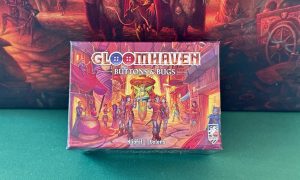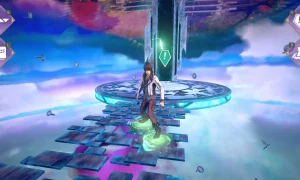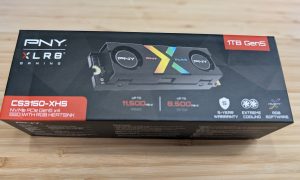If you asked me to make a wishlist of games I’d love to see get the budget and time to bring to life for a new audience, Homeworld is near the top of that list. Relic Entertainment created the first two titles, but the series has lain dormant since 2003 (Unless we count Deserts of Kharak, the ground-based RTS). Beyond my wildest hopes, Gearbox Software swooped in and picked up the franchise with a full remaster of both original titles, as well as a prequel, a mobile game, and even an adjacent game with the highly-recommended Hardspace: Shipbreaker. What we were all waiting for Blackbird Interactive to do was take us back to space. Homeworld 3 seemed like an impossible dream for so long…but it’s finally here. Since this series has such a long and storied history, let’s take a very abbreviated look at the previous titles.
Homeworld told the story of the Kushan people. Deep in the desert of their planet Kharak they found two things that would change the vector of the entire species – a stone obelisk containing a map of the stars with a planet labeled “Hiigara”, and a massive ruin of a ship (the Khar-Toba) with a hyperspace drive that could carry them there. Unified under this new purpose, the Kushan worked for the next decade to bring a massive “Mothership” to life that could carry 600,000 Kushan across the stars to this new world. The Mothership pilot, Neuroscientist Karan S’Jet, had discovered a way to replace an impossibly-large crew with just a handful of people – wiring herself directly into every system and becoming Command. On their maiden voyage they make their first leap only to be greeted by a hostile carrier that immediately launched fighters to destroy the Mothership. Limping back to Kharak they find the world in flames. Hiigara translates as the word “home”, and for the last 600,000 Kushan people aboard, it represents their last and only choice. The game follows their journey home, hunted by ancient enemies and the dangers of the expanse.
Homeworld 2 begins with the Hiigaran people (the Kushan who have now settled on Hiigara). The broken and battered original Mothership has been retired and repurposed to build their new society, so a new Mothership, the Pride of Hiigara, has been commissioned. The original core they found in the desert of Kharak was just the first of three, with the second in the hands of a Vaygr Warlord named Makaan. His intent is to conquer the world of Hiigara and to reclaim the first core. Uniting all three is said to bring about the end of days and the return of a mystical being named Sajuuk. On the Pride’s maiden voyage, the Vaygr attack, forcing Karan S’Jet to once again carry the Hiigaran people across the stars. Desperate for a weapon to stop the otherwise-overwhelming Vaygr forces, the Karan S’Jet and the Hiigaran people race to reclaim the final core. In doing so they discover that the messianic Sajuuk are actually a progenitor race that built the cores in the first place. Destroying the Makaan in an epic final battle, the Higaarans now possess all three cores, abandoning the Pride of Hiigara and now piloting the progenitor ship back to Hiigara. She had ascended, becoming the Sajuuk-Khar and protector of the three cores – the Age of S’Jet, an age of enlightenment and discovery, had begun.
Homeworld 3 begins 20 years after the end of the previous game. Karan S’Jet had unlocked a massive and interconnected set of hyperspace gates that would allow the Hiigaran people to explore the stars. In the Outer Rim, a region of space from which no ship has ever returned, lies The Anomaly. The hyperspace gates that once enabled instantaneous travel throughout the galaxy had become dangerous and unpredictable, stranding, destroying, or losing ships entirely. Meanwhile, The Anomaly continues to spread, darkening gates that fall under its sway. Karan S’Jet, piloting the Khar-Sajuuk, left to investigate the gates, and like so many before her, she never returned. Her protege, Imogen S’Jet boards the new Mothership Khar Kushan to find out what happened to Karan, and to stop The Anomaly for good.

My summary simply doesn’t do the story of these three games justice. I highly recommend you check out the Homeworld Remastered Collection to see it unfold for yourself. While it’s not required for Homeworld 3, there are a lot of moments and places that’ll be immediately recognizable. For example, it’s one thing to say “Ok, I have to do this trench run on either side of this gate”, and it’s entirely another to say “Ah, this is the Eye of Aaraan” and to immediately know the significance of this place.

The game kicks off with your first choice – control presets. You can choose from Modern, Legacy (Homeworld 2-style / Homeworld Remastered controls and feedback) and Customize which lets you mix, match, and blend to your heart’s desire. This is a direct result of the hard work the team put into the Homeworld Remastered Collection. The delay that Homeworld 3 saw that placed it into 2024 was also a direct response to feedback that fans gave from the beta, including controls, and Homeworld 3 is the beneficiary. I went with the new Homeworld 3 controls, and I can see that the delay time was well worth it. The hybrid controls were easy to adapt to, and I never experienced the trouble selecting or using my fleet effectively, minus a few bugs we’ll discuss later.
As a new navigator, Imogen is facing situations she’s never encountered in simulation, and it’s far from smooth space-sailing. The Khar-Kushan is not fully combat capable, as she launched earlier than planned. Her production module is limited, so one of the first stops is an automated facility housing a prototype production module. It’s in this way that the Khar-Kushan will grow – additional modules acquired along the way, or as we would say in the military, “Procure on site”. Recovering derelict ships, or disabling an enemy craft and hauling it back to the Khar-Kushan for capture unlocks new technologies, as do some events that occur through the campaign.
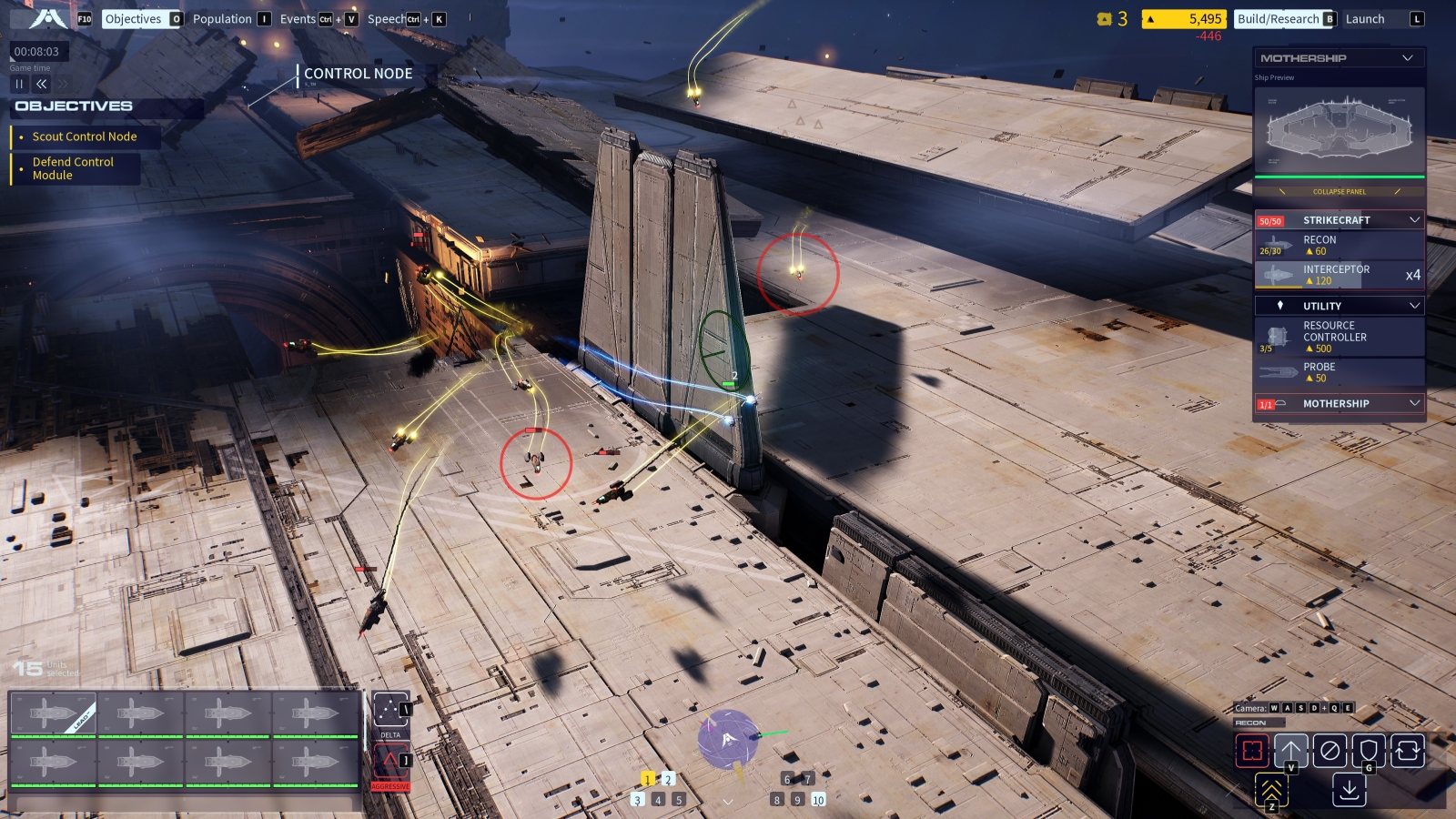
The mission structure is set up in such a way that they don’t feel like separate missions, but more like one continuous saga. The Khar-Kushan initiating hyperspace and hurtling across the stars gives way to a cutscene that immediately moves into the next mission as she comes out of the void. There is no hard cut between missions. Similarly, the game frequently, and to great effect, switches to a cinematic camera to build tension and highlight various things. This can be unveiling a ship for the first time or watching as a squadron of fighters screams out from behind a nearby asteroid hiding place, setting on the Khar-Kushan before she’s had time to deploy her fighters. It’s like watching an episode of Battlestar Galactica mixed with The Expanse, and more than once I got goosebumps when combined with the soundtrack.
Ohhhh the soundtrack. Paul Ruskay returns to the franchise, having composed the haunting music of Homeword, Homeworld 2, Homeworld: Deserts of Kharak, and now Homeworld 3. I could describe it, but frankly you just need to set aside 20 minutes of your day to watch this making-of piece entitled Adagio for Homeworld: Creating the Sounds of Homeworld 3 with Paul Ruskay. In it, Ruskay describes how he resurrected Adagio for Strings and other classical music to bring the haunting world of Homeworld to life. Combined with music from all over our world, he set out to make music “a trigger for memory”, and wow does he succeed. It’s truly magnificent and worth picking up.
One of the things that I’ve always appreciated about Homeworld is the radio chatter. Your troops are members of the Hiigaran military, and as such their communications between each other comes across calm and collected – they have military bearing. They’ll complain about rations, report in for formation, or complain about an issue with their comms, but when engaged in combat they go full military bearing and are calling out positions, fire for effect locations, losses, an enemy trying to rabbit, and other combat squawks. This continues in Homeworld 3, of course, but with a lot more input from command and Imogen this time around, telling you to reinforce group 2, or that group 7 is taking heavy losses, etc. It really personalizes the troops, and it makes you think about them a bit more than just using them for cannon fodder.
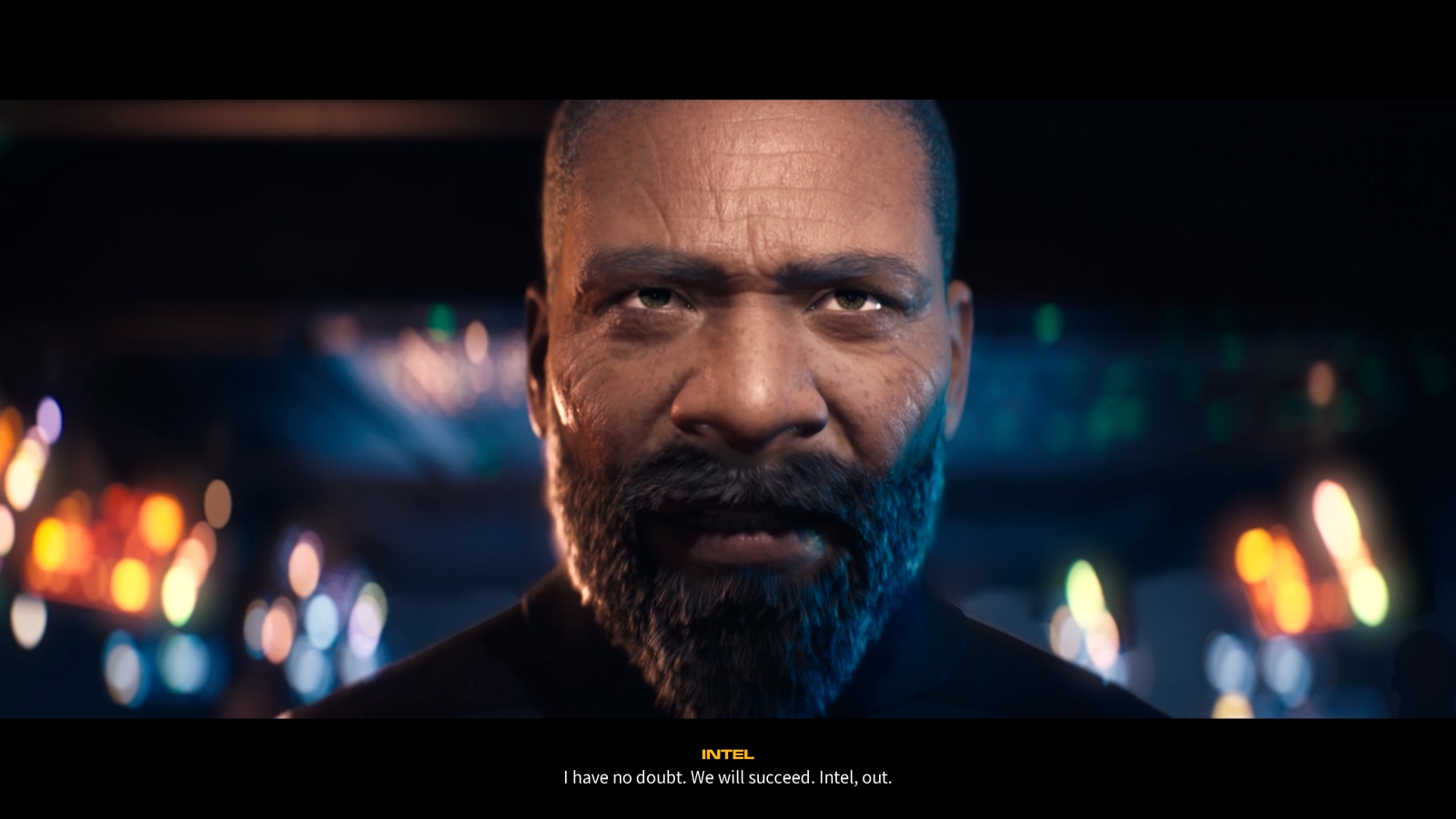
The cutscenes are a massive step up for the series, showing what Imogen is experiencing as the integrated navigator of the Khar-Kushan. The previous games have told the story via a painterly style of still images with minimal animated components. There are elements of that here, but now we have fully motion-captured and beautiful cutscenes. Rather than just occurring at the end of missions, these now occur during a mission, telling a cinematic story throughout. They also cleanly blend the current mission and the next, meaning there is no longer a jarring line between levels.
Homeworld 3 runs on Unreal Engine 4, and it looks gorgeous. It also means you can have hundreds of ships scrapping it out on screen, launching ordinance and switching formations as they fight. It also means you can have massive megalithic structures, often impossibly large ships or gates that have been partially destroyed, spreading chunks of debris around the space. This is where the biggest change for Homeworld comes in. While the first game gave us the concept of fighting in 360 degrees, Homeworld 3 asks us to start to think about cover. During one mission you’ll be approaching a famous landmark that I won’t spoil here, with two trenches on each side. You can head right up the pipe, squaring off against the stationary defenses spread throughout, or you can trench run using passive stance, pop up behind a chunk of debris, and capture the objectives quietly. I never expected to use stealth in Homeworld 3, but this game is stuffed to the gills with new experiences.

One of my favorite parts of Homeworld 3 is the surprising variety of environments. One moment the Khar-Kushan becomes disabled, using what little bit of time it has before coming to rest to dive into the cosmic dust below. This little debris nebula is the only cover the ship has while it undergoes repairs, and I felt a real shiver up my spine. My ship’s sensors are disabled, her combat capability is near zero, and enemies could walk right up and knock on our hull and we’d never see them coming, much less be able to stop them. Later you’ll be holding position outside of a gate, defending with everything you’ve got as a near inexhaustible and technologically advanced fleet pours through. I don’t want to ruin these moments, but suffice it to say that there’s a whole lot more than the cold vacuum of space here.

If you are not interested in the cooperative mode, that’s fine. The game holds up entirely fine with or without it. That said, War Games is a very cool new addition to the mix. In it, up to four players can experience Homeworld 3 beyond the boundaries of the single player campaign. Let’s start with the critical thing – looking the part.
When you fire up War Games you’ll select your faction (I don’t want to spoil the factions as that’ll spoil some of the single player components), as well as your fleet’s color scheme and emblem. There are about two dozen emblems to choose from, including a few that are locked behind the upgraded editions of the game, and a handful of SHIFT rewards. The color wheel is the entire spectrum (though lacking a box to punch in hex codes) for your badge, hull, stripes, and engine trails. You can also select from 18 fleets based on in-universe presets, with the last two again being locked behind the Fleet Command Edition.
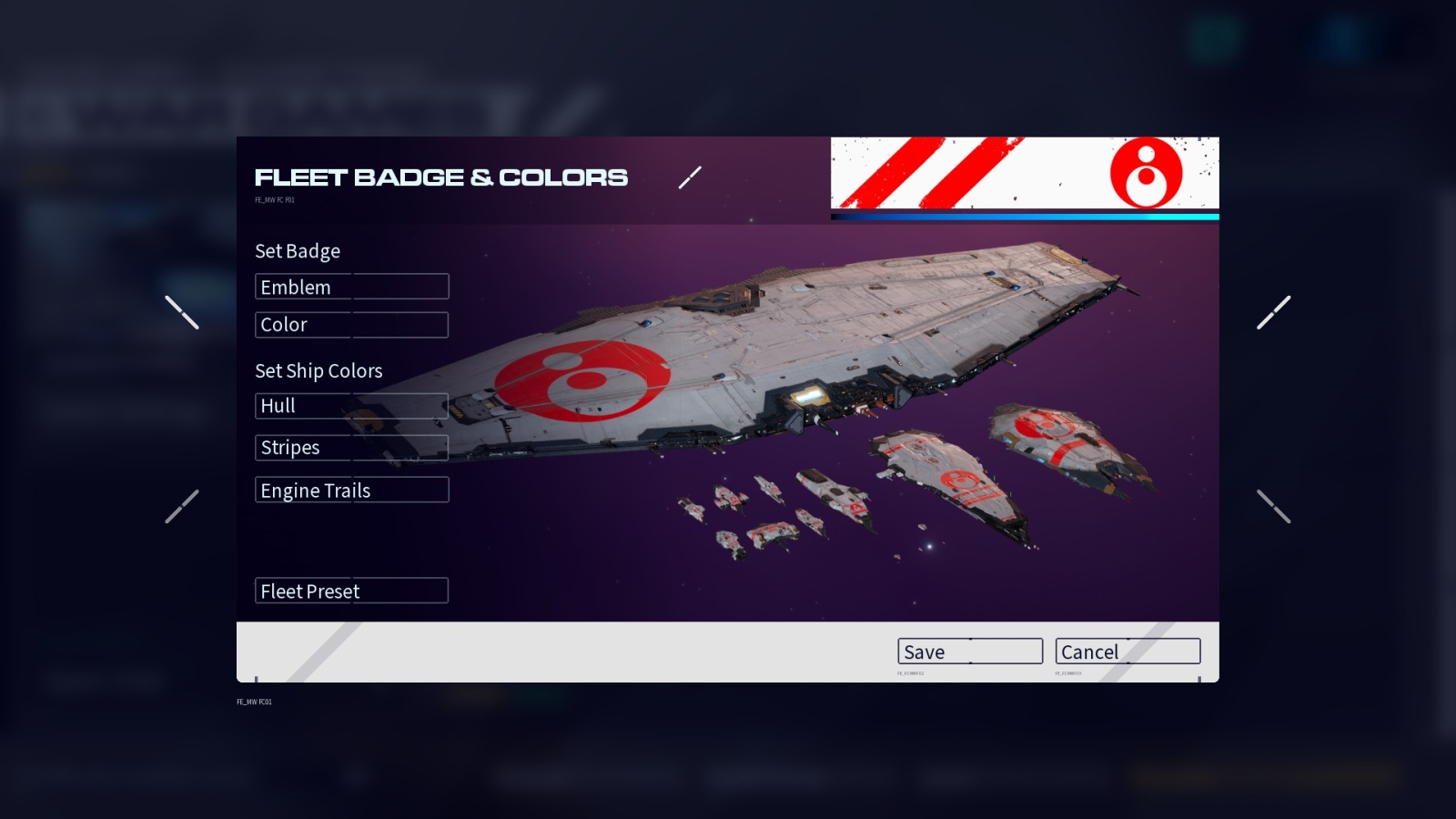
With your fleet looking the part, you’ll make your next crucial decision – your fleet composition. Initially, you’ll only have the basic Strike Craft Fleet, but each run will earn you XP (win or lose) that will unlock other fleet types as you learn how to play. Here’s your loadout:
Strike Craft Fleet – Level 0
1 Carrier, 5 Recon Fighter, 5 Interceptors, 1 Resource controller
Reconnaissance Fleet – Level 3
1 Carrier, 6 Interceptors, 1 Resource controller
Reconnaissance Fleet – Level 5
1 Carrier, 2 Torpedo Frigates, 1 Resource controller
Incarnate Fleet – Level 10
1 Carrier, 4 Dominance Fighter, 3 Assault Corvette, 1 Resource controller
Platform Fleet – Level 15
1 Carrier, 2 Resource controllers, 4 Dominance Fighters
Experimental Fleet – Level 20
1 Carrier, 8 Beam fighters, 1 Resource controller.
This is, of course, your initial loadout. While you have no Mothership to command, most of your fleet can be constructed from the far more nimble Carrier. It just means you won’t have access to things like mine layers and assault craft, much less secondary carriers – this is all about speed and flexibility. The setup is simple — you and your fleet have been stranded deep in enemy territory, and working with your invited friends, you’ll battle your way across the stars and back to Hiigaran space.
Even more than the solo game, this mode very much feels like the countdown clock portions of early Battlestar Galactica episodes. The fleet is relentless, brutal, and always pressing. When you jump you’ll get a handful of objectives, and completing them yield artifacts. These present as three options for upgrade.
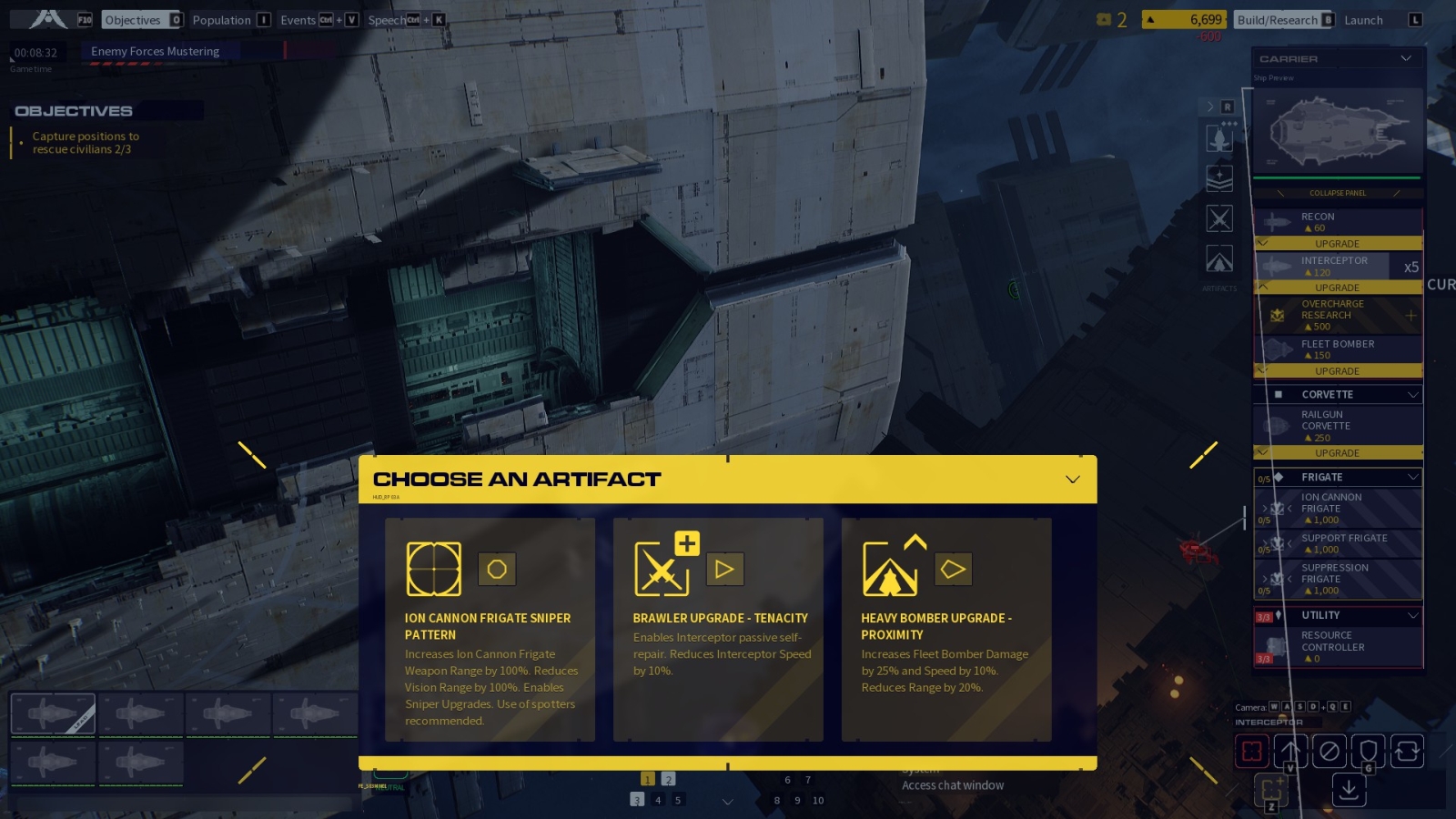
As you dust enemy ships, if you can recover them, you’ll also find additional artifacts to keep raising your fleet’s technical capabilities. Every artifact you activate has a solid advantage, such as additional range, damage, armor, cluster munitions, long-range sniper modes, and much more. These also carry tradeoffs that you’ll have to consider. Something that gives you an extended reach might make your hull weaker as a consequence – perfect for a sniper frigate, but terrible for a recon unit…unless you view them as expendable fodder. These artifacts and incidental recovery operations are often just off the beaten path. This is problematic as the longer you wait in the conflict zone, the stronger and more numerous the waves of enemies become. Risk and reward, like everything else.
Just like in the single player game, you’ll have to balance recovery of RUs with your resource controllers. You’ll also have to balance research, crafting new ships, and building upgrades before the enemy’s number overwhelms you. Some incursions can be handled with nimble fighters, and others might require a more balanced fleet. Being fast on your feet is the name of the game.
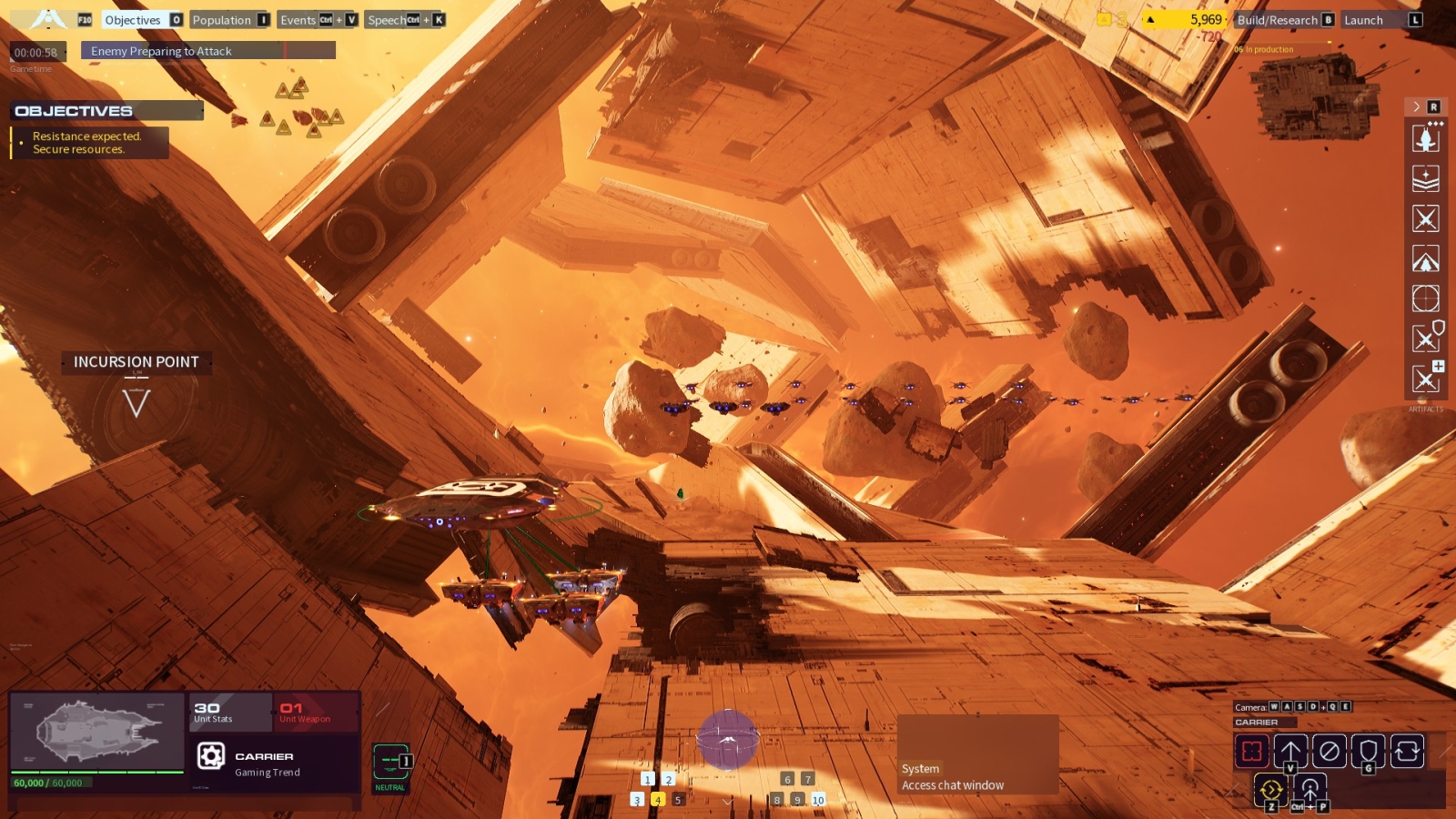
War Games will take you roughly 45 minutes to an hour to complete, with your fleet needing to make three jumps to survive. The enemy in these modes are not stupid – they’ll use the clearly marked incursion points, yes, but they’ll also utilize trenches, debris, and other obstacles to ensure they stay hidden until the moment to strike is right.
There are ten difficulty levels that are available from the word go. These can be things like additional objectives in the first or second mission, larger incursion forces, carriers that do not respawn, and much more. You can select some, all, or none of these, providing XP bonuses anywhere from 0 to +500%.
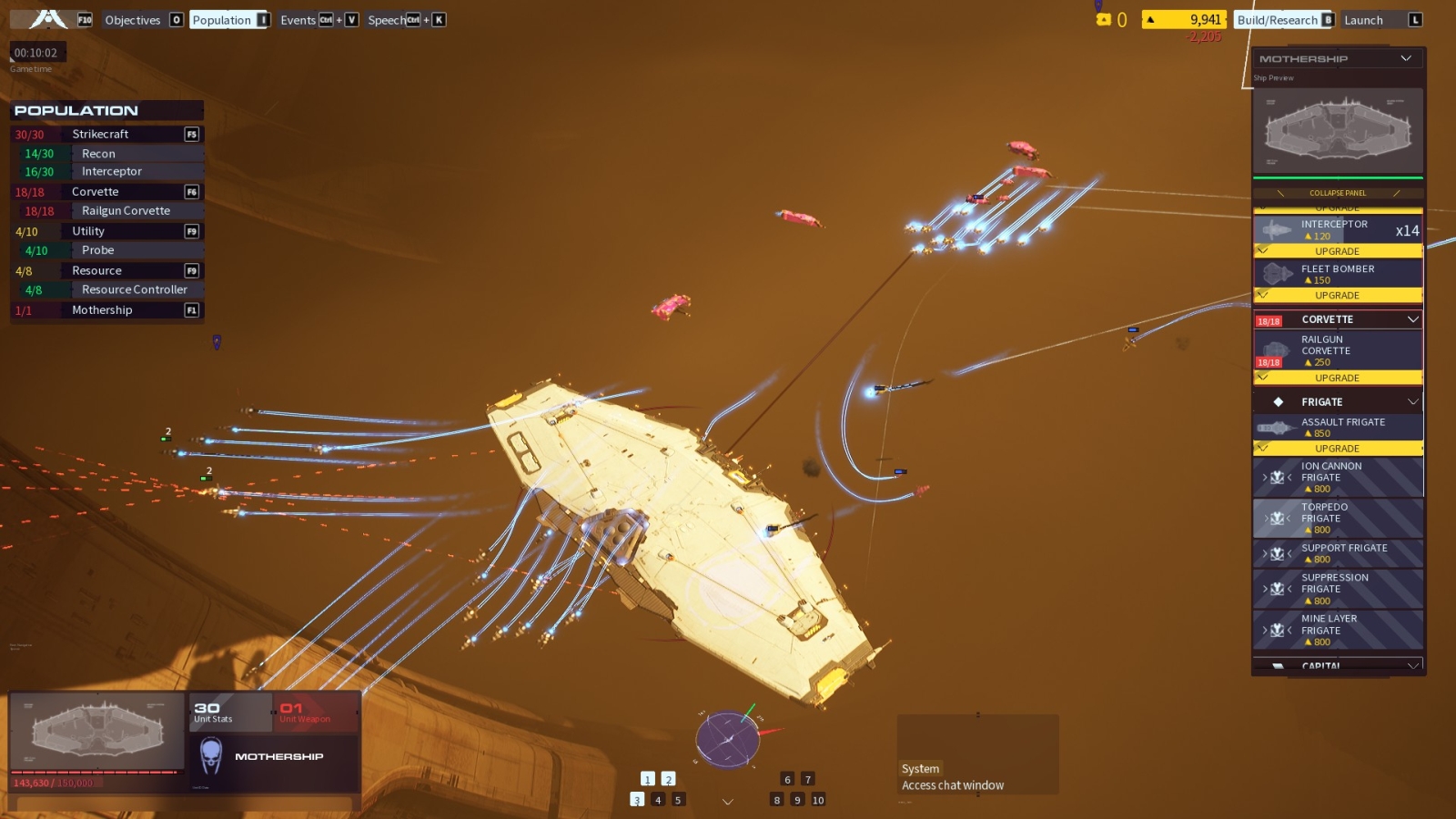
In addition to War Games you also have the option to go toe to toe with the AI in a Skirmish mode, and here you’ll have a Mothership at your disposal, with all the additional fleet options that it provides. In this mode you can tackle six maps (at launch, more already on the roadmap), and up to five AI players. You are welcome to arrange these as foes are allies as you see fit, setting their fleet type and more to meet your challenge. You can also set the win conditions – destroy all ships, destroy all production, or just destroy their Mothership. Additionally you can set a time limit from 30, 60, 90 minutes, or unlimited if you are so inclined. Starting Resources (from 0 to a million RUs), how many resources are on the map (100% to 300%), and how many resources are injected into the map per minute (from 0 to 10,000 RUs) are all additional toggles you can tweak to make the game run the way you wish.

The launch of Homeworld 3 is fantastic, for the most part, but there are still some remaining bugs that need repairing. I’ve had entire fleets sail through solid objects such as a megalith structure. I’ve also run into a showstopping bug where, during a mission where salvaging two ships was required, my resource collectors snapped up the ships and carried them back to the Khar-Kushan, only to refuse to actually capture or salvage them, and only restarting the entire mission four times got me past it. The worst bug, however, has to be the occasional loss of my cursor. When this bug happens, the game becomes almost unplayable. Thankfully this is a rare occurrence, but over the course of a dozen hours it’s happened four times, and restarting the entire game was necessary to fix it. When I’ve seen this bug in other games it’s often resolved by updates to drivers and a patch or two, so I’m hoping that’s the case here. This game has shipped in an absolutely magnificent state, and I’d hate for this handful of bugs to mar it long term.

“Unable to salvage” bug.
I’ve been waiting since 2003 for a proper sequel for the Homeworld series. Offshoots and remakes gave us hope, but it’s finally here. I had impossibly high expectations, and somehow Homeworld 3 has exceeded all of them. The fact that it not only recaptures the magic of the original, but also elevates it in new ways is magnificent. Throw in the new and frankly unexpected War Games and the future for the Homeworld universe looks bright. Today, we’re all Hiigaran, and Homeworld 3 is home.
Ron Burke is the Editor in Chief for Gaming Trend. Currently living in Fort Worth, Texas, Ron is an old-school gamer who enjoys CRPGs, action/adventure, platformers, music games, and has recently gotten into tabletop gaming.
Ron is also a fourth degree black belt, with a Master's rank in Matsumura Seito Shōrin-ryū, Moo Duk Kwan Tang Soo Do, Universal Tang Soo Do Alliance, and International Tang Soo Do Federation. He also holds ranks in several other styles in his search to be a well-rounded fighter.
Ron has been married to Gaming Trend Editor, Laura Burke, for 28 years. They have three dogs - Pazuzu (Irish Terrier), Atë, and Calliope (both Australian Kelpie/Pit Bull mixes), and an Axolotl named Dagon!

Homeworld 3 is everything I hoped it could be. It improves on its predecessors in every conceivable way, and adds meaningful new features including a cooperative War Games mode. I never thought it would happen again, but I’m happy to report…the mothership has cleared the scaffold...we are away once again.
PROS
- Recaptures the magic of the originals
- Gorgeous setpieces and ships
- Revamped controls are an upgrade
- Roguelike War Games mode is a hit
- New cutscenes are fantastic and interlaced throughout
- There’s still nothing like Homeworld
CONS
- A handful of bugs remain
See below for our list of partners and affiliates:










